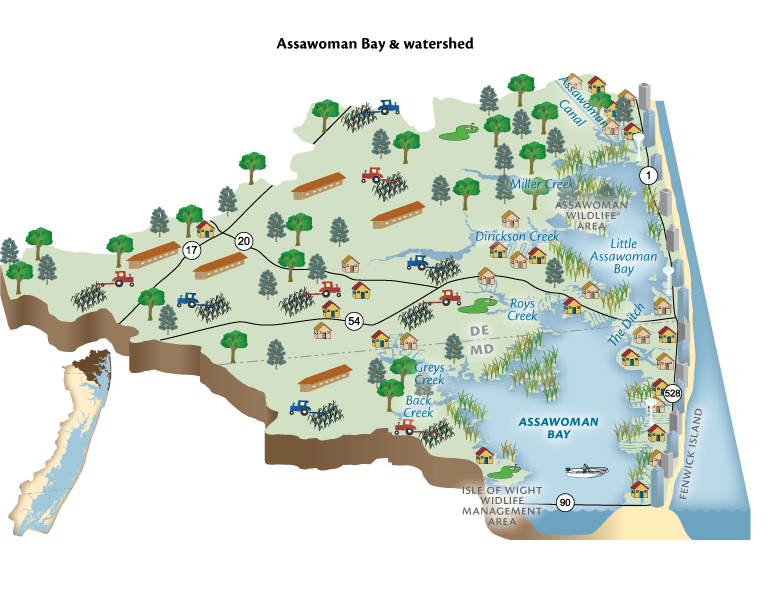
General Description
Assawoman Bay’s drainage includes both Worcester and Sussex counties, with over 40% of the drainage in Delaware. The northern half of Ocean City drains to Assawoman Bay. Grey’s Creek is the primary tributary that drains into Assawoman Bay in Worcester County.
Ecosystem Health Ranking
- Ranks 4 out of 5
- 2021 Maryland Coastal Bays Report Card
Challenges
Assawoman Bay’s health remains impacted due to the urban development of the watershed, particularly in Delaware and Ocean City. This has fragmented forest and non-tidal wetland cover. Development creates impervious surfaces (pavement, rooftop, compacted soil), which degrades stormwater quality and impacts water quality in the bay.
Agricultural use also contributes to impaired water quality. Agricultural activities such as tillage and the application of manure/poultry litter/chemical fertilizer/pesticides can contribute pollution to our waterways. There are several poultry operations and over 1,000 acres in crop production in Maryland’s portion of the watershed.
Key Current Solutions
In November of 2004, Delaware developed a Total Maximum Daily Load (TMDL) for nitrogen and phosphorus for Little Assawoman Bay. Non-point source nitrogen and phosphorus loads in the watershed are to be reduced to 40%.
Worcester County completed a watershed plan for Assawoman Bay in 2019 that meets specific EPA standards, making the watershed eligible for federal grants for restoration projects. The plan identifies actions to reduce nitrogen load including septic conversions, stormwater retrofits, tree planting, and wetland restoration. The state, county and MCBP will work with Sussex County and the state of Delaware to merge their plans into one cohesive plan.
Conservation practices, often referred to as BMPs (Best Management Practices) are implemented on farms. These include conservation tillage, cover crops, forest buffers, and other practices. Over one third of the cropland in the watershed is placed in cover crops annually. Farmers also implement various other practices with support from USDA and the state’s Soil Conservation Service that reduce non-point source pollution.
Greys Creek Nature Park was acquired by the State and transferred to the County in 2006. This 517-acre property on the creek contains woodland and tidal marsh that provide important habitat and water quality benefits, as well as a place to learn about the bay ecosystem. The property is managed cooperatively by MCBP and Worcester County and will eventually be open to the public. Shoreline restoration on the property has contributed to improved water quality and habitat and serves as a demonstration project.
How You Can Help
- Plant native trees and other plants on your property
- Reduce or eliminate use of fertilizer
- Clean up after your pet
- Reduce travel by vehicle—combine trips or walk/bike
- Learn about the watershed you live in—volunteer, visit a park, or attend informational events about the coastal bays
- Install a rain barrel or a rain garden to treat stormwater
- Get your septic system pumped regularly and ensure it is working optimally
